

|
| DEUTSCHLAND | GERMANY |
| Bundesland: Freistaat Sachsen | Saxony |
| Landkreis: Vogtlandkreis |
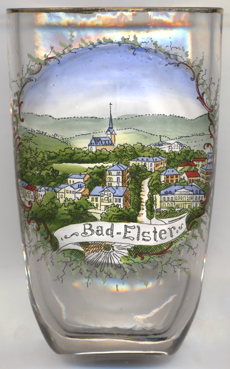
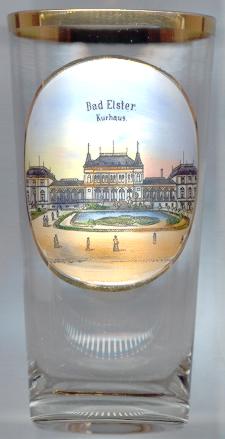 Bad Elster, Saxony's most famous spa, is situated at an elevation of 460 m in the valley of the river Weiße Elster in Southwest Saxony close to the border to the
Czech Republic. The village Elster was first mentioned in a document of 1324. The first analysis of the mineral waters was published in 1669. The first stone well for the springs
was built in 1789. Elster soon gained some popularity and attracted visitors such as the German poet and naturalist Johann Wolfgang von Goethe (1795). Following the discovery of
new mineral springs in 1810 the popularity of the spa increased so that it received the status of a Royal Saxon Spa in 1848. The predicate 'Bad' (spa) was added to the name in 1875.
Further springs were discovered in 1873, 1923, 1935, 1956 and 1957. Bad Elster received the status of a town in 1935.
Bad Elster, Saxony's most famous spa, is situated at an elevation of 460 m in the valley of the river Weiße Elster in Southwest Saxony close to the border to the
Czech Republic. The village Elster was first mentioned in a document of 1324. The first analysis of the mineral waters was published in 1669. The first stone well for the springs
was built in 1789. Elster soon gained some popularity and attracted visitors such as the German poet and naturalist Johann Wolfgang von Goethe (1795). Following the discovery of
new mineral springs in 1810 the popularity of the spa increased so that it received the status of a Royal Saxon Spa in 1848. The predicate 'Bad' (spa) was added to the name in 1875.
Further springs were discovered in 1873, 1923, 1935, 1956 and 1957. Bad Elster received the status of a town in 1935.
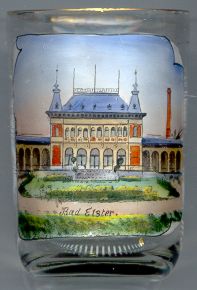
The  Kurhaus [near left, no. 938; right, no. 1440, and below, no. 4202: top picture]
was built in 1888–1890 in Neo-Renaissance style.
The Kurhaus is used for concerts and exhibitions, and also houses Bad Elster's municipal library.
There are also plans for creating a large spa museum within the complex.
Kurhaus [near left, no. 938; right, no. 1440, and below, no. 4202: top picture]
was built in 1888–1890 in Neo-Renaissance style.
The Kurhaus is used for concerts and exhibitions, and also houses Bad Elster's municipal library.
There are also plans for creating a large spa museum within the complex.
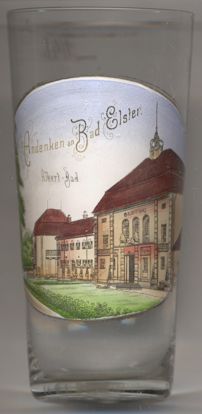
The  Albert-Bad
Albert-Bad
[https://badelster.de/touristinformation/stadtrundgang/albert-bad]
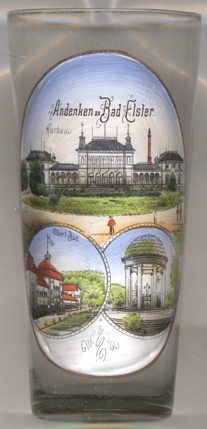
The  Flora-Tempel
Flora-Tempel
[https://badelster.de/touristinformation/stadtrundgang/flora-tempel]
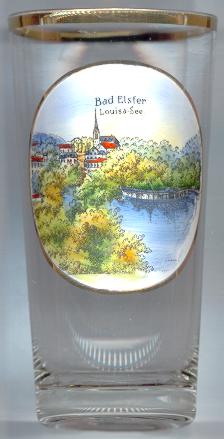
The  Protestant church Trinitatis [left, no. 939: background] was built in neo-Gothic style in
1889–1892 by the architect Christian Gottfried Schramm. The mighty west tower has a height of 54 metres. It houses two wooden statues of the apostles
St. Peter and St. Paul of around 1490 which originally stood in the old church of St. Peter and Paul which stood next to the new church until 1892.
Protestant church Trinitatis [left, no. 939: background] was built in neo-Gothic style in
1889–1892 by the architect Christian Gottfried Schramm. The mighty west tower has a height of 54 metres. It houses two wooden statues of the apostles
St. Peter and St. Paul of around 1490 which originally stood in the old church of St. Peter and Paul which stood next to the new church until 1892.
[https://de.wikipedia.org/wiki/St.-Trinitatis-Kirche_(Bad_Elster)]
The artificial lake  Louisa-See [right, foreground] was created in 1893–1895 from an emptied mud depot.
It was later named named after Crown Princess Luise of Saxony (1870–1947). Luise (Ludovica Antonia of Habsburg-Lothringen, Princess of Tuscany) married Crown Prince Friedrich August of Saxony (later King Friedrich August III) in 1891,
but never enjoyed the life at the Royal Saxon Court. When she was pregnant with her sixth child in 1902 she fled from Bad Elster together with the music teacher of her children, Enrico Toselli (1823–1926), because she feared
of being sent to a mental asylum by her husband's family. The marriage was dissolved in 1903. When she tried to re-enter Saxony illegally in 1904 to see her children again, the Saxon police expelled her from the country
which caused a large scandal in Germany. She married Toselli in 1907 but was divorced again in 1912. Toselli's piece ‘Serenata’ became something of an international 'hit',
being transcribed for many different instruments.
Louisa-See [right, foreground] was created in 1893–1895 from an emptied mud depot.
It was later named named after Crown Princess Luise of Saxony (1870–1947). Luise (Ludovica Antonia of Habsburg-Lothringen, Princess of Tuscany) married Crown Prince Friedrich August of Saxony (later King Friedrich August III) in 1891,
but never enjoyed the life at the Royal Saxon Court. When she was pregnant with her sixth child in 1902 she fled from Bad Elster together with the music teacher of her children, Enrico Toselli (1823–1926), because she feared
of being sent to a mental asylum by her husband's family. The marriage was dissolved in 1903. When she tried to re-enter Saxony illegally in 1904 to see her children again, the Saxon police expelled her from the country
which caused a large scandal in Germany. She married Toselli in 1907 but was divorced again in 1912. Toselli's piece ‘Serenata’ became something of an international 'hit',
being transcribed for many different instruments.
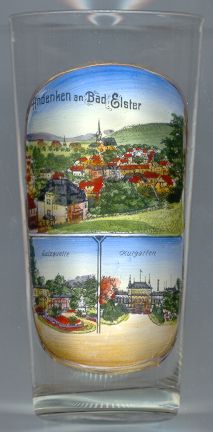
The  Salzquelle (Salt Spring) [near left, no. 1553: bottom left, and below, no. 1770]
was first curbed in 1851. The old building of the pump room for the Salt Spring and the Moritz Spring
(shown on glass no. 1553, left: bottom left) was built in 1860. It was replaced by a new construction in Bauhaus style in 1928/1929,
which was re-opened after restoration works in 1994 and houses both the Salzquelle and the
Salzquelle (Salt Spring) [near left, no. 1553: bottom left, and below, no. 1770]
was first curbed in 1851. The old building of the pump room for the Salt Spring and the Moritz Spring
(shown on glass no. 1553, left: bottom left) was built in 1860. It was replaced by a new construction in Bauhaus style in 1928/1929,
which was re-opened after restoration works in 1994 and houses both the Salzquelle and the
 Moritzquelle
Moritzquelle
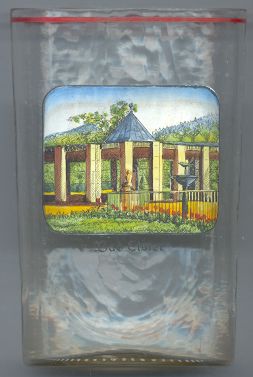

![[scale]](lineal.jpg)